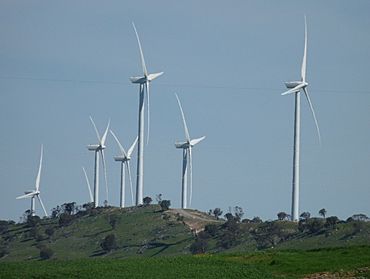Waterloo, South Australia facts for kids
Quick facts for kids WaterlooSouth Australia |
|||||||||||||||
|---|---|---|---|---|---|---|---|---|---|---|---|---|---|---|---|

The Waterloo windfarm looking southwest along the Tothill Range
|
|||||||||||||||
| Established | 1865 | ||||||||||||||
| Postcode(s) | 5413 | ||||||||||||||
| Location | |||||||||||||||
| LGA(s) | District Council of Clare and Gilbert Valleys | ||||||||||||||
| State electorate(s) | Frome, Goyder | ||||||||||||||
| Federal Division(s) | Grey | ||||||||||||||
|
|||||||||||||||
| Footnotes | Coordinates | ||||||||||||||
Waterloo is a small community in South Australia. It's located off the Barrier Highway, between the towns of Manoora and Black Springs. Waterloo is about 121 kilometres (75 mi) north-east of Adelaide, the capital city of South Australia.
Discovering Waterloo's Past
Waterloo was officially set up as a town in 1865. It's found in an area called the Hundred of Waterloo, which is part of the County of Light. The town got its name from the famous Battle of Waterloo, a big battle during the Napoleonic Wars.
Waterloo sits in a valley at the very beginning of the Light River. It's roughly halfway between the towns of Kapunda and Burra. Don't mix it up with Waterloo Corner, which is closer to Adelaide!
In 1866, people living in Waterloo asked the government for a police station and a courthouse. However, the government said no because the town was still very small. At that time, it only had about six houses, a flour mill, and one hotel.
Waterloo is also famous as the birthplace of Tom Kruse. He was a well-known Australian mailman who delivered mail across the outback. He worked on the challenging Birdsville Track, which is in the border area between South Australia and Queensland.
How Land is Used in Waterloo
Even though Waterloo never grew into a big city, it became an important place for the farms around it. It offered services like a school, churches, and shops for the local farming community.
Today, Waterloo is still in the middle of a very productive farming area. It continues to provide services to the people who live and work there. You might also notice large windfarms built on the hills nearby, which help create clean energy.
Kunden: A Nearby Community
About two and a half miles (two point five miles (4.0 kilometres)) south of Waterloo is a place called Kunden. This area was originally named Carlsruhe. It was settled in the 1800s by German immigrants. They built the Carlsruhe Lutheran church and a cemetery next to it.
In 1918, during a time of war, many German place names in Australia were changed. Carlsruhe was renamed Kunden because of a law passed by the government. The Carlsruhe school, which once had 44 students, closed in 1917. This happened because new laws required all students to be taught in English, not German.
Today, Kunden is part of the larger Waterloo postcode area. The only things left from its original name are the church, the cemetery, and Carlsruhe Road.


